Saturday, June 5, 2010
Temporary Switch
Thursday, June 18, 2009
Consummate Salesmen
There is no other solution for American cities. If you look across the globe, the only cities that have actually shifted people from private cars back into public transit are cities that have built bus rapid transit.The BS detector is huge on this one. Not only is Curitiba losing people to private vehicles because of the crush loaded conditions, the chief of the system has admitted they have to build a subway. Might I also add, there are many cities that aren't in third world countries that have amazing transit systems to emulate. Such as Paris, Berlin, Vienna, London, and Madrid etc....(H/T Frank M) How about a yellow tram that's six segments and comes every minute like in Budapest?
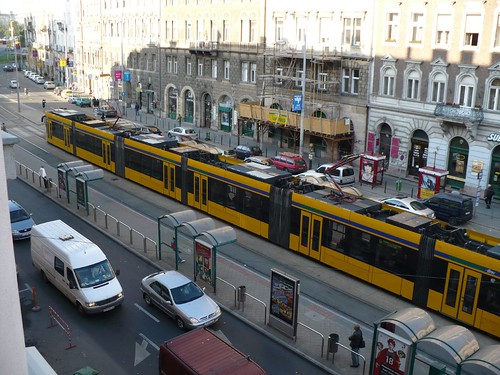
There's way more capacity there than on an articulated bus. 173 feet of tram every minute. And it would certainly do some heavy hauling across Manhattan. Anyone want to take some civic leaders to Budapest with me? As Daneel states:
The big order was for the world's busiest tram line, along the Grand Boulevard (lines 4/6). This is nothing to be proud of, the daily 200,000/hourly max. 10,500 passengers would be in the capacity range of a subway. But an orbital subway was never built, so pairs of "Industrial Articulateds" transport the masses in close succession. So when finally new vehicles were ordered, they were for the world's longest passenger trams (precisely 53.99 m; only the CarGoTram freight trams in Dresden/Germany are longer [59.4 m]). The new series 2000II got the nickname Óriáshernyó (=giant caterpillar).
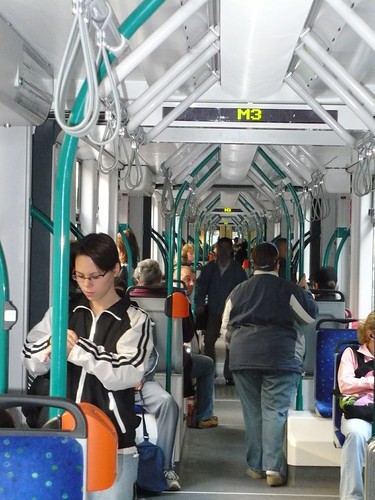
But another quip I have with Walter is his flip flopping and misleading statements. In his BRT post on Streetsblog, Hook nonchalantly states that BRT can cost as little as $8 million a mile.
Very good BRT systems have been built for as little as $8 million a mile. With the same capital budget, we could build more than twice as much proper BRT as light rail, probably 5 to 10 times more, with no loss in the quality of service, the capacity, or the speed.First off he's comparing cheap non-BRT Rapid bus to full LRT. That is hardly an even comparison. The Healthline BRT in Cleveland which is the closest thing we have to that type of BRT on city streets in the United States was $29 million per mile ($200/6.8mi). The Portland Streetcar cost $24m/mi. If we just took lanes from cars and inserted the rails instead of rebuilding whole streets the capital costs would be comparable and operating would be much less. More riders, less drivers.
Look, if you want a big network of Rapid Bus or BRT in a major city go ahead and do it. Los Angeles has been fairly successful when they aren't trying to expand like Krispy Kreme in 2000. That is an excellent model to emulate for routes that need better transit service right away. But let's not pretend that BRT or Rapid Bus works on the corridors that actually need rail or a Subway like Second Street.
Finally, there is this:
Hook is hoping it works. He says at least one American city should have a well-designed BRT, one that really does feel like a train.If you want something that feels like a train, then why not build a train. I'll never understand why cheap is always the best option to some people. You get what you pay for.
Monday, February 16, 2009
Taking or Easement?
In Portland, the Lake Oswego rapid streetcar would run on an existing easement that allows the rail line to run. If the current shoreline trolley stops operating, the easement reverts to the original landowners. This was discussed in recent comments at Portland Transport.
Saturday, January 24, 2009
Using What You Purchase
Though I would hope that they don't use the whole thing, at least further east towards the beach. The closer the ROW gets to the beach, the closer it gets to a large Naval Air Station, which is likely not too great for mixed use development unless at some point it is shut down and the property is redeveloped. Close by however is a major shopping district that could be recast after its useful life as a new center for Virginia Beach. Currently it has a lot of parking spaces ripe for redevelopment. You can see the difference between the two probably paths below.
 You can also see in the aerial below that there is a wide median for ROW. However such a large street could use a boulevard reconfiguration to calm traffic and create better pedestrian scale development.
You can also see in the aerial below that there is a wide median for ROW. However such a large street could use a boulevard reconfiguration to calm traffic and create better pedestrian scale development.
 The extension to Virginia Beach also seems like a good line from a job connection standpoint as well. Three miles from the end of the current line under construction and west of the Naval Air Station above is this job and entertainment center below called Virginia Beach Town Center.
The extension to Virginia Beach also seems like a good line from a job connection standpoint as well. Three miles from the end of the current line under construction and west of the Naval Air Station above is this job and entertainment center below called Virginia Beach Town Center. The point however is that while this is a good line, they need to look long and hard into where it goes, and might want to think about how much the ROW is worth beyond the Naval Air Station. It's probably worth buying and keeping for the future because if the NAS is decommissioned, a rapid streetcar could connect the station with the beach and start and end at light rail stations as well as circulation. But it's something to look into.
The point however is that while this is a good line, they need to look long and hard into where it goes, and might want to think about how much the ROW is worth beyond the Naval Air Station. It's probably worth buying and keeping for the future because if the NAS is decommissioned, a rapid streetcar could connect the station with the beach and start and end at light rail stations as well as circulation. But it's something to look into.
Tuesday, December 9, 2008
Rediculous Costs + Dumb Ideas
Monday, November 17, 2008
Airport Rapid Streetcar?
If the money is already raised, why not build a rapid streetcar line between the Colosseum and the Airport terminal with limited stops. Currently the bus line comes every 10 minutes or so and actually makes money. One of the reasons is because its so packed all the time. There have been a few times when I have had to wait for 2 buses to pass in order to get to the airport. Even if the separated the streetcar from traffic, it would not cost $122 million per mile.
With the route I've drawn out below, it would promote office development and for more than just airport riders to take the line and provide a direct link to the airport. It would however be a little bit longer at 3.9 miles, but would get its own lanes and have a consistent travel time. I'm also pushing it through the stadiums because at some point, this land will be much too valuable to just leave as a parking lot and should develop more like urban ballparks and stadiums around the country with proximity to transit. This line could also use value capture strategies to fund improvements or the line itself.

At 3.9 miles, you could certainly build the rapid streetcar for the $250 million already raised. I bet they could have some money left over for other projects.
Saturday, August 16, 2008
NYT Streetcar Article Makes Impression
But in the last few days, that one article set off a flurry of streetcar articles around the country.
Los Angeles - Downtown business organization sets up Streetcar Non Profit.
Over its first eighteen months, LA Streetcar, Inc., would look to raise just under $400,000. The money would be used to advocate and coordinate the streetcar effort.Pasadena - An editorial in the town paper on beginning to consider streetcars
And the thing about such momentum is that streetcar building is so much simpler than other kinds of transit, with tracks that don't require deep digging, that city blocks are just closed down to auto traffic for a few weeks. And Seattle's line was up and running in December of last year just four years from the time it was conceived. That's unheard of in the transit world.Minneapolis - The city has a streetcar network plan, they look towards Seattle and Portland for ideas. Also check out this "new to me" blog Twin Cities Streets for People.
An investment blog, Common Census, has an interest in the investment opportunities around streetcars. This is the first time I've seen this outside of the transit blogosphere.
As major cities look to build new streetcar systems and extend additional lines, investors should be aware of the potential opportunities these new public transportation lines could bring.Treehugger makes the point about dedicated right of ways and calls Randall O'Toole full of %$!*
I would politely suggest that Mr. O'Toole is full of crap- I live in a streetcar city and the lines do not all go downtown, they do connect with the subway which does, but are used to go in all directions by all kinds of people. Drivers hate them (they are hard to pass and definitely slow down automobile traffic) but riders love them. When dedicated rights-of-way go in, they become fast, dependable and have huge capacity.The Chronicle of Higher Education makes the case that streetcars and transit in general are good for student populations and school coffers.
And while streetcars can save hundreds of dollars a year in commuting costs for students and others, the lines save millions for universities that would otherwise have far more serious parking problems — and many more costly garages and space-hogging lots.
Tuesday, July 29, 2008
Seattle Viaduct Retrofit Nixed
"We have taken the retrofit off the table," said Dave Dye, deputy secretary for the Washington State Department of Transportation, "but we will do one more piece of due diligence."Why is this only being reported by the West Seattle Herald?
Monday, April 28, 2008
Streetcar Scalability and Capacity
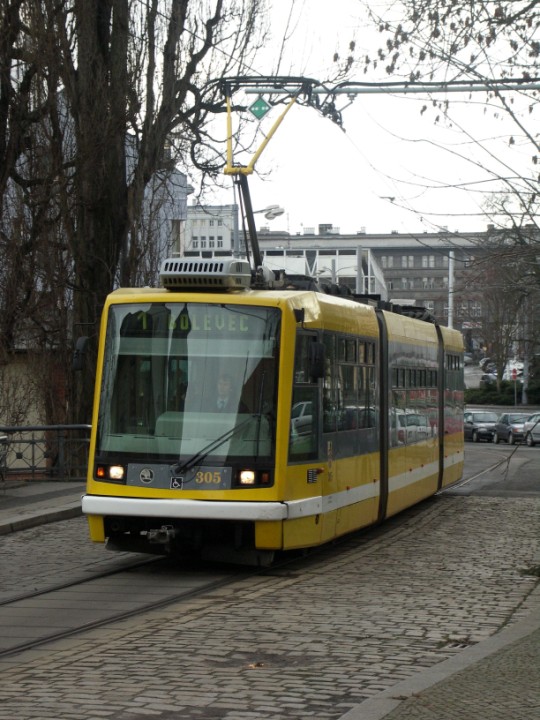
 Photos Courtesy of NYCSubway.org
Photos Courtesy of NYCSubway.orgThe next option is the modular tram. Basically, you can build to specifications you want. According to the Siemens website, they c trams from 18 to 72 meters (60 feet to 236 feet) almost 4/5ths of a football field.
 Sorry for the bad picture but I stole it from Tom Furmaniak's powerpoint on streetcar tech.
Sorry for the bad picture but I stole it from Tom Furmaniak's powerpoint on streetcar tech.Real Examples below:
Combino - 3 Sections
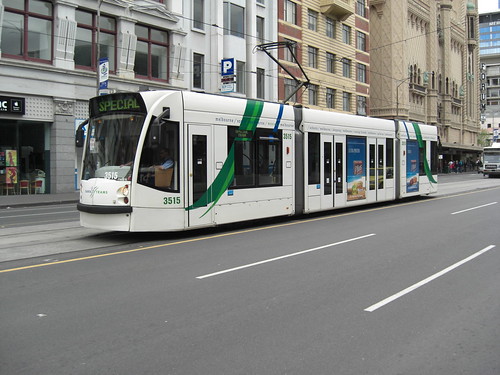 Flickr Photo by: Johnzebedee
Flickr Photo by: JohnzebedeeCombino Ultra - 5 Sections
 Photo Courtesy of Gen Gibson
Photo Courtesy of Gen GibsonCombino Supra: 6 Sections
 Flickr photo courtesy of Tschaut
Flickr photo courtesy of TschautThis is the same for the other tram companies including Ansaldo Breda, Skoda, Kinky Sharyo, Bombardier, and Alstom's Citadis Tram.
Thursday, April 17, 2008
Clay Chastain Keeps Attaching Conditions
Streetcars are a subset of light rail.
Streetcars are a subset of light rail.
Streetcars are a subset of light rail.
Streetcars can be coupled.
Streetcars can be coupled.
Streetcars can be coupled.
Streetcars can run in their own lane.
Streetcars can run in their own lane.
Streetcars can run in their own lane.
So with that out of the way, it seems dumb that the only way you'll accept a transit plan for a city is if you're so rigid that you limited the plan to one technology. And by limiting the plan to one technology, he's ignoring that there is a way to get what he wants with streetcars if that is a more workable alternative. This is what made Clay Chastain's plan for Kansas City Light Rail unworkable in the first place. He mandated that the line include building an Aerial Tramway over a park and that it had the electric system of Bordeaux France without an overhead wire even though the proprietors of the technology have said they weren't bringing it over anytime soon. But putting it exactly the way he thought it should be on the ballot without doing any engineering was what killed it.
Sigh. No wonder no one wants to work with him, he keeps attaching conditions. At the same time, the Mayor is looking to lay the groundwork for a regional rail system. He seems to be starting to look at it the right way, with a starter line. The other cities that have gotten networks started have built a small starter line first; Houston, Denver, Salt Lake City, and Minneapolis. Now they are all expanding, some albeit faster than others.On further reflection however, Chastain has come up with a possible compromise.
“This is an idea that should electrify the entire city and end the cold war between me and the city,” he says. “If there is a settlement between the parties, and the city wants me to support their light-rail plan in November, I will do so.”
Under certain conditions.
“I will do so only if the transit technology for the main spine is conventional light rail and not streetcars,” Chastain says. “And if there is a direct connection to Union Station, and if the city agrees to put on the same November ballot an ordinance in which the voters can choose whether or not to do away with Section 704 of the City Charter allowing the City Council to repeal or amend voter-initiated ordinances.”
But I guess the whole point of this post was to say you can configure these transit technologies to do whatever they need to do. Just saying "I don't want light rail" or "I don't want streetcars" is silly. The things that matter are what the right of way is like and the capacity needed on the line. I can understand when folks say "I don't want it in mixed traffic." But don't write it in stone so that you can't have a small section on the line that might only have that option if the ROW in the corridor is too narrow.

Europeans laugh at us. They call them all trams.
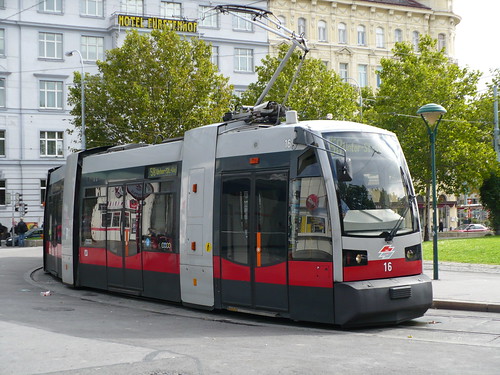
Sunday, April 6, 2008
Streetcars: Getting Out of Our Silos
When we look at streetcars from a purely transportation standpoint, we are missing the point. We are creating silos in which to put different aspects of the city. Transportation here, land use here, city fiscal responsibility here, and the environment here.
If we are to look at the overall benefits and needs, we see that there is a great benefit to streetcars when they are appropriate which I believe they were in Portland and Seattle given the goals of these lines. The goals implicitly or explicitly were to tie downtown to a new neighborhood that would boost walkability and livability in the city for more people. There is an important lesson for how cities benefit from transportation such as the streetcar.
1. The Corridor vs. Node
Streetcars are not meant to be rapid transit but rather pedestrian accelerators within districts and areas just outside of town. If you think that streetcars are the solution to everything, you are wrong. A system is needed but how the technology influences land use is important to the decision. Given that the streetcar is pedestrian scaled, it creates a corridor of pedestrian oriented development. This is why many of the first ring suburbs have commercial strips that were once served by streetcars. It's also why many of the former interurban lines formed small towns around the station, just like light rail creates a node of development today. Two different transit modes, two different purposes.
2. Streetcar Corridors Create More Density/Value
More density means more rooftops means more close retail means more walking. This is important because when we build new neighborhoods we want people not to do the same things they do in sprawl. The key to the streetcar is increasing the envelope for density on a corridor. In fact the streetcar in Portland pushed developers to get closer to their density maximums closer to the line. 90% of the envelope was filled one block from the line. 75% two blocks and further down. Seattle is doing the same thing. Building at higher densities that would usually be built because of developer confidence in the future of the streetcar.
But why is this important? Well it means that over the long term, that piece of land will create more tax revenue than whatever dreck was built next to the bus line. So when we look at the streetcar funding issue versus the bus, how much more value was created for the community? What is the tax creation of a 10 story building over 100 years versus a 5 story building? So in the whole scheme of things, the bus is a cheap alternative that in the end costs the city more. We need to get out of that silo.
3. It Creates the Pedestrian Experience
Part of the reason for building the streetcar and creating the density is creating a good pedestrian and street environment. Who wants a bus running by your dinner? Your coffee?

But also, the creation of a pedestrian environment and pedestrian accelerators increased the area folks are willing to walk. And the creation of more of these neighborhoods on a corridor by streetcars is important because this increased walking has been shown to reduce VMT. In fact the 7,200 housing units along the Portland Streetcar line have been estimated to reduce VMT by 53 million miles a year. Thats nothing to sneeze at and will be something that decreases greenhouse gases. But all of this is not attributable to the streetcar, but to the creation of a walkable environment from the densities and streetscapes. Developers are more willing to create these densities and places with the streetcar instead of a bus.
As I have said before, its not always about speed. Creating an environment for pedestrians means also a slower environment, a safer environment. While 43,000 a year die on the highways, I heard this weekend from Rick Gustafson of Portland Streetcar Inc that the Streetcar has had accidents, but no one has been seriously injured.
So while a bus might be more flexible, as a circulator and distributer the streetcar serves a community organizing purpose. It is not for every corridor and in fact it might animate less used streets such as the North-South streets chosen for Portland's streetcar. That does not mean that the route should travel away from the preferred corridor such as Guadalupe street in Austin and Guadalupe should have a dedicated lane due to its traffic volumes. But these are decisions that should be made based on the location and with the whole vision in mind. We need to stop thinking in our silos and think about and articulate all the benefits of certain investments from all standpoints, not just transportation and moving people. After all, thats all the highway engineers do and look what it gets us, big roads that move cars faster while killing street life.
Sunday, February 24, 2008
More Rapid Streetcars
Both are discussing using exclusive lanes in the street to move much faster than traffic. The applications however are a bit different. Ann Arbor is looking to build lines on four main corridors and feed them with neighborhood shuttle buses. It's more like a city tram system.
The Davis County version is a feeder to commuter rail and would travel in its own lane except in two places. I wish I knew where those two places were but I'm guessing we'll find out eventually.
Friday, January 18, 2008
That Sounds Kinda Expensive
It will also allow any further light rail expansion to the east side and create a second river crossing for light rail which would be important should one of the bridges go down in the chance of an earthquake. This is all about expanding the network as Metro Councilor Robert Liberty States.
As Liberty sees it, completing the Portland-to-Milwaukie line will keep the promise of the original system and open up new possibilities, including an extension to Oregon City and east-west connections that do not pass through downtown Portland.As I think further about this and look at the distance, even with the bridge section, 6.5+ miles at a billion dollars seems like a lot of money. It works out to around $150 million per mile (without the bridge section costs). Are they building a trench for it? Is it a subway? Especially since the Yellow Line was under budget and $60 million per mile in 2004. Folks at Portland Transport are commenting on this as well. I wonder what costs so much? Specifically after the Portland folks have gotten good at the track work after the Streetcar and Yellow Line. We really need to reign in these cost issues or new lines will never be built. I believe thats what the opposition wants, as well as our very best friends in Washington DC. Perhaps its time for the rapid streetcar but we'll figure out what is behind the costs soon.
Saturday, December 15, 2007
Lake Oswego Rapid Streetcar Steps Toward Reality
This would be the first modern application of the Rapid Streetcar idea. It would connect to the City of Lake Oswego to the South Waterfront Streetcar while using the same vehicles.
Tuesday, November 20, 2007
Denial Isn't Just a River in Africa
Jeter and Lucas said they're willing to discuss options with CATS because they're not against the train, just the funding plan.
Swain said those on her board opposed to TIF financing are "wrestling with their ideological philosophies and the mandate of the people."
Two weeks ago voters approved keeping a Mecklenburg County half-cent sales tax that funds transit projects, such as the train.
Jeter said the 70 percent support of voters for maintaining the tax wasn't a "mandate from the Huntersville residents that they want commuter rail in Huntersville."
He said the train is part of the town's future transportation solution, but that roads should come first. The town doesn't spend any of its money on road building, but it should, he said.
How soon is the future? Most have said its now. The transit opponents all said "This is a referendum on the trains". How quickly things change. My feeling is that, if they don't want it, start on the downtown streetcar. The black community in Charlotte who rallied for the transit tax and were promised a sped up streetcar construction timeline will be more willing to build now than these folks.
Thursday, October 25, 2007
Waiting for Austin...
Thursday, August 2, 2007
Planned Streetcar Networks
Portland: Obviously their first line has been a success and now they are looking to expand. Citizen planning has already begun and a review of corridors will be underway shortly. They also have a leg up given the United Streetcar folks would make cars for them in town.
Seattle: Construction on the South Lake Union streetcar line is almost complete and there are plans for a more extensive network. There are maps in this report.

Minneapolis: After the success of the Hiawatha Line, Minneapolis is ready for expansion. They are in the third stage of planning for a streetcar network downtown that would consist of a number of corridors.
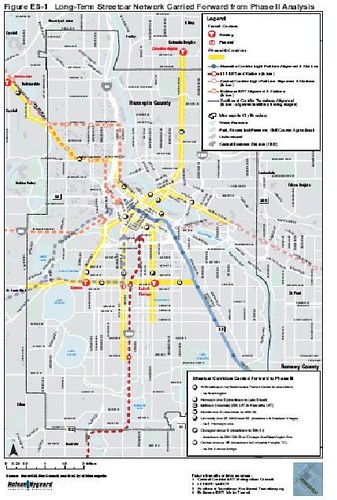
Washington DC: Plans for a streetcar network are beginning with the Anacostia Streetcar however they have hit a snag with some overhead wire rules that have been discussed earlier in the blog. But that hasn't stopped them from planning corridors or having the first streetcars tested.

Some cities such as Baltimore are hopeful, but haven't gotten into the planning stages yet.
I think its important to think big. As i've said before, one line does not a transit system make, and its important to have a network so people can go more places. Streetcars serve a certain short hop circulation service in street and can be used for shorter line haul operations but there are some jobs that light rail, commuter rail, heavy rail, or bus can do better. But there's nothing like a good land use plan and a streetcar to rebuild a neighborhood.
(Sorry for the picture quality, but I took screen shots from the linked PDFs)
Saturday, July 28, 2007
Portland Blogging
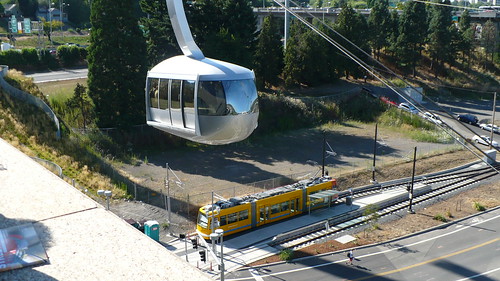
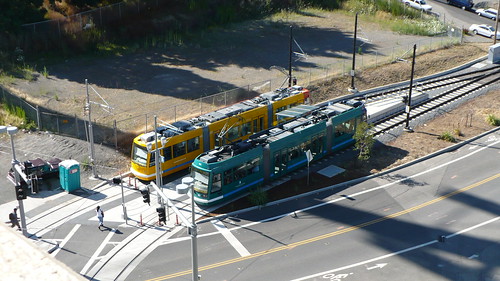
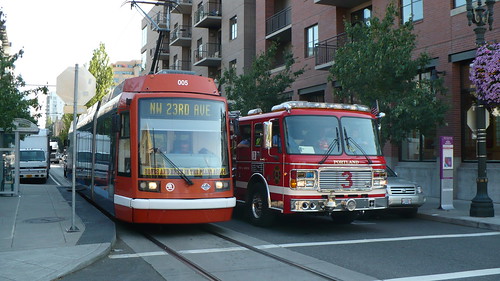
Here is a picture of a firetruck and a streetcar. It was pretty cool and they stayed there for a sec while I took a picture. I'm not sure if it was for me, but if it was, thanks!
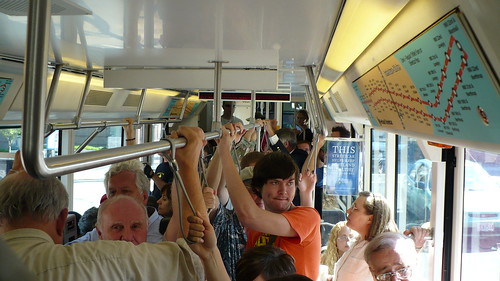
As with the F-Line, it was a crush load on a lot of the cars I saw. In fact it's so full during the afternoon that it's hard for some folks to get on. They need more operating funding so cars can run more often, because every 12 minutes doesn't quite cut it.

We went on the tram and got a testimonial from a doctor that was a skeptic before she started riding it. She said she wondered why they were spending so much money on it, but now she gets it. Instead of 30 minutes during rush hour to get between patient visits in the South Waterfront and OHSU campus, it now takes her 7. It's no surprise that its won her over. It's apparently won over folks who wanted to bike, but didn't like the hill.


Here is traffic to Lake Oswego, better get that rapid streetcar sooner than later.
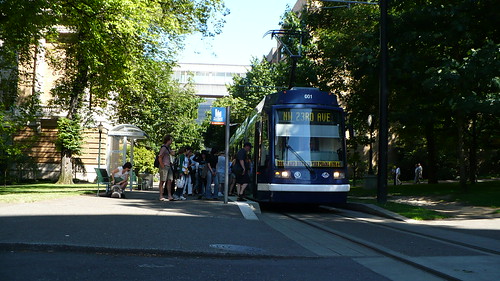
And here is a streetcar in the park for good measure. I'll update later as I upload more photos. Enjoy!!!
Monday, July 2, 2007
Transit Network: Fort Worth
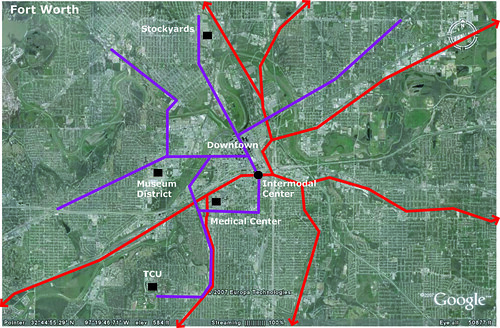
The Rapid Streetcar
Streetcars are cheaper because of their lower infrastructure requirements. Often there is no need to relocat utilities, right of way does not need to be purchased and the stops are smaller and the vehicles more pedestrian oriented. Streetcar stops are also closely spaced if the goal is to be a circulator or short line transport mode. However if a longer distance transit mode that mimics light rail is what you're looking for, but your city is on a budget, the rapid streetcar might be your choice.
Many cities have taken up the mantle of the rapid bus to be their cost effective alternative to light rail, but only do this based on cost, not because its what the citizenry wants. Recent Rapid Bus movements in Oakland, San Francisco, and Charlotte have shown that people really want light rail on a budget but haven't been able to engineer their systems to reduce costs and are therefore left with an inferior transit mode for their stated goals.
But by using streetcars in center lanes with single tracking and passing sidings at stations you can get the same performance as light rail on 10 minute headways. Streetcars aren't single vehicles either. Skoda streetcars have couplers on them as well that would make them multiple car consists. The lighter vehicles are about 66 feet long as opposed to 90 foot LRVs yet you can still get increased passenger capacity and lower infrastructure needs. You can see in the picture below from Skoda.

This fascinating development in value engineering is nothing new and has been rarely used in the United States if at all. A recent extension of the Portland Streetcar to Lake Oswego might be its first test. Literature on the subject has been presented at TRB by Lyndon Henry and has been extensively covered by Light Rail Now! Recent publications including Raise the Hammer in Canada as well as the folks in Kansas City have been looking to this option. This technology and engineering arrangement is a smart way for cities to get rapid transit and build the system they want and can afford, not the system they settle for.
